With more than 9 popular platforms to choose from, small businesses use social media in ways that best suit the unique needs of their business. Social media provides opportunities for small businesses to grow their brand authority and expand their audience.
Social media is an important component of an effective marketing strategy for 62% of small businesses. The 9 largest social media platforms, however, present different challenges for small businesses looking to maximize their resources and reach specific goals such as increase website traffic, build brand awareness, and grow followers.
Although nearly all small businesses use Facebook, they invest differently in platforms such as Instagram, YouTube, LinkedIn, and Pinterest according to their industry, the age of their owner, and their marketing goals and resources.
Visual Objects surveyed 529 small businesses in the U.S. to discover which social media platforms they use and why. In this survey, we refer to small businesses as having between 1 and 500 employees and limited revenue, which aligns with the Small Business Administration’s definition of a small business.
Businesses can use this report to gain a deeper understanding of the risks and benefits associated with different social media platforms.
Our Findings
- Almost all small businesses that use social media (89%) have a Facebook account for their business, which shows Facebook’s enduring popularity and value for businesses.
- Some industries use certain social media platforms more than others – more than half of small businesses in the retail and hospitality industry (56%) use Instagram compared to 42% of small businesses in the financial industry.
- Small businesses with 50 or more employees invest in more social media channels such as Facebook (85%), YouTube (69%), and Instagram (63%) compared to small businesses with fewer than 50 employees.
- Nearly 90% of small businesses (88%) plan to invest more in social media channels, but the channels they will invest in vary based on the generation of the company owner.
- Nearly half of survey respondents (48%) plan to invest more in Instagram and YouTube – channels that Generation Z prefers.
- Most small businesses (64%) will not decrease investment in any social media platforms in 2019. Once small businesses have social media accounts, they tend to keep them.
- One-quarter of small businesses (25%) use influencers to help with social media marketing, which could explain the increased investment in Instagram.
Facebook Remains the Most Popular Social Media Platform for Small Businesses
Facebook’s 2.3 billion monthly active users and sophisticated marketing capabilities make the platform the most popular choice for businesses. Almost all small businesses surveyed (89%) have a Facebook account.
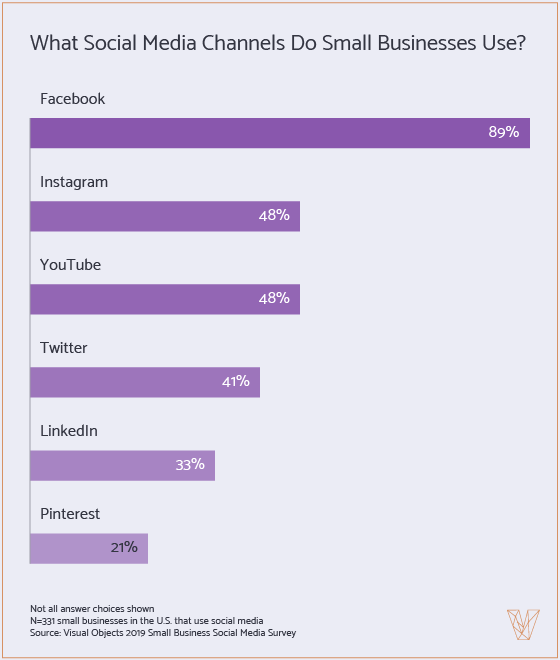
Almost half of small businesses use Instagram (48%) and YouTube (48%), and 41% use Twitter.
Only 33% of small businesses use LinkedIn, and fewer than a quarter use Pinterest (21%) and Snapchat (18%).
Cydney Hatch, social media manager at digital marketing firm Disruptive Advertising in Lindon, Utah, said Facebook continues to have value for small businesses because it’s the social media channel with the highest number of regular users.
“Businesses need to appear where their target audience is spending their time online,” Hatch said. "What businesses need to understand about social media, particularly Facebook and Instagram, is it’s all about showing up with the intention of building relationships. A lot of times, marketing campaigns miss the mark by having one-way communication with their customers."
Facebook’s large user base – and the data it provides – makes the platform a valuable marketing channel for small businesses. Facebook also owns Instagram, which has a similar advertising power.
Small businesses, however, must use Facebook with the intention of building relationships rather than strictly promoting a product or service.
"If you want to make money using Facebook, you need to go out and find as many people as you can help to achieve their goals or solve their problems. When you have the answer, your goals will take care of themselves," Hatch said.
Facebook also has business account tools can help measure and extend small businesses’ reach on the platform.
“Everything is trackable,” said Brandi Zatorski, marketing manager at LYFE Marketing in Atlanta. “You can see very quickly which creatives are working, which audience is working, which campaigns are working, and which aren’t. That way, you can allocate your budget into whichever campaigns are performing.”
Facebook’s sophisticated tracking materials make it easy for businesses to measure their efforts’ success. The image below shows how businesses can view notifications in one place.
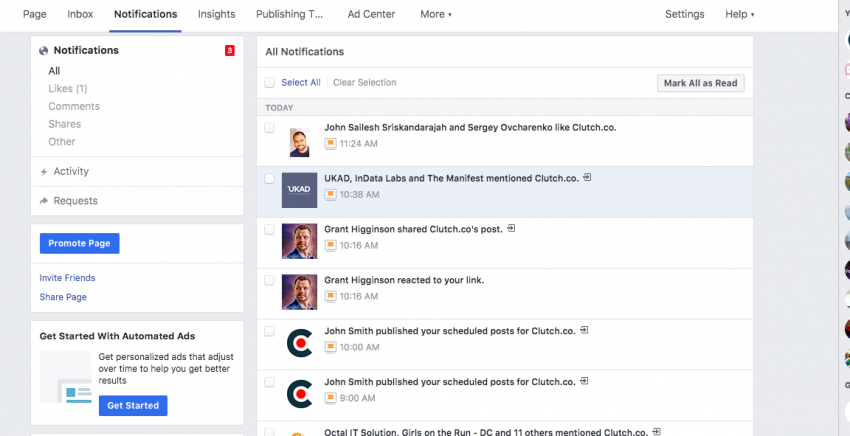
Businesses can view notifications on Facebook and respond to comments or messages easily.
Facebook has also become an important place for small businesses to build a community around their brand.
“What Facebook wants to ultimately accomplish is to drive conversation and drive community,” said Keith Kakadia, founder and CEO of SociallyIn, a social media agency in Birmingham, Ala.
Small businesses can use Facebook groups to attract and engage audiences interested in their brand.
Social media is an important tool for small businesses looking to expand their reach, but platform use depends on a business's industry.
Small Business Social Media Use Varies by Industry
Small businesses use social media differently across industries.
More than half of small businesses in the retail industry (56%), for example, prefer visual social media platforms such as Instagram to promote their product or brand. Only 42% of small businesses in the financial industry report using Instagram.

According to Rachel Knights, social media and marketing coordinator at Imagine Media Consulting, a social media company in Atlanta, business to business (B2B) companies use social media differently than business to consumer (B2C) companies.
“If you’re a B2B company and you’re looking to generate leads, LinkedIn would be a good place to spend your money,” Knights said. “LinkedIn is going to cost more per result because generating a lead takes a lot more than just getting a ‘like’ or having somebody follow you. The cost per result might be a little bit more, but it’s worth it.”
LinkedIn might cost more for small businesses at the outset, but B2B companies looking to generate leads should include the platform in their social media marketing strategy.
B2B small businesses should develop their LinkedIn strategies around building relationships. Robin Scott is a director of Silicon Dales, a B2B e-commerce development company in the United Kingdom. He uses LinkedIn to drive brand awareness through networking.
“I use LinkedIn to communicate with colleagues in [my] industry,” Scott said. “It's probably best as a recruitment tool or to network with people who might refer your business.”
LinkedIn offers tools for businesses and individuals to connect with potential clients or even potential new hires.
Cold-contacting prospects on LinkedIn, however, may have adverse effects for a B2B company.
“As a B2B service provider, I get a lot of requests for us to subcontract some element of our work,” Scott said. “I really don't think this type of cold contact is a good starting point for a strong relationship.”
Small businesses should study industry trends to identify the right social media channels for their business.
Most Small Businesses Plan to Invest More in Social Media
Social media is a highly customizable and trackable marketing tool for small businesses, often requiring minimal time and financial investment up front.
Most small businesses (88%) will increase their investment in social media in 2019, which shows that social media remains a valuable digital marketing strategy for small businesses.
Almost two-thirds of small businesses (63%) plan to invest more in Facebook in 2019.
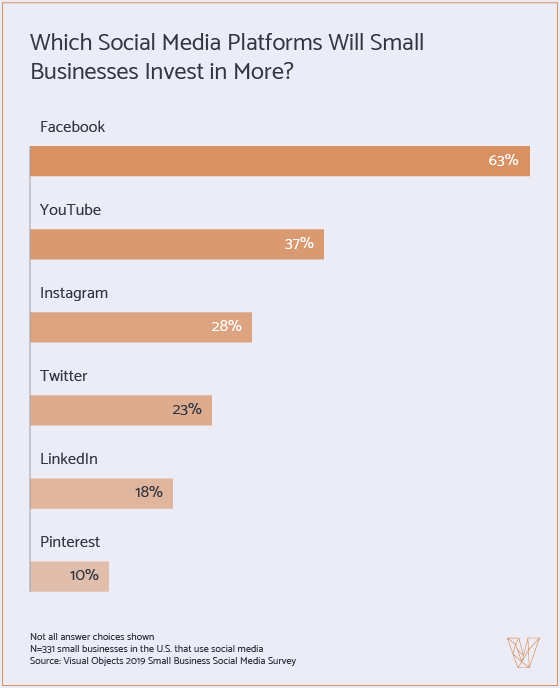
Some small businesses plan to increase their investment in platforms that rely on visual and video content. More than one-third of small businesses (37%) plan to invest more in YouTube, and 28% will spend more on Instagram.
Almost one-quarter of small businesses (23%) will scale up their investment in Twitter, and only 18% will increase investment in LinkedIn.
One-tenth of small businesses also plan to build their presence on niche social media platforms such as Pinterest (10%) and Snapchat (10%).
Instagram Helps Small Businesses Drive Brand Awareness
Instagram’s growing user base and versatility makes it an alternative for small businesses looking to drive engagement and brand awareness. For example, Instagram implements new features that facilitate consumer interaction with brands.
“Recently, Instagram added a quiz option on [its] Instagram stories,” Knights said. “It’s a fun way to build engagement while also educating your audience on your brand.”
Instagram launched a quiz feature in April 2019 that allows brands to include multiple-choice questions on stories.
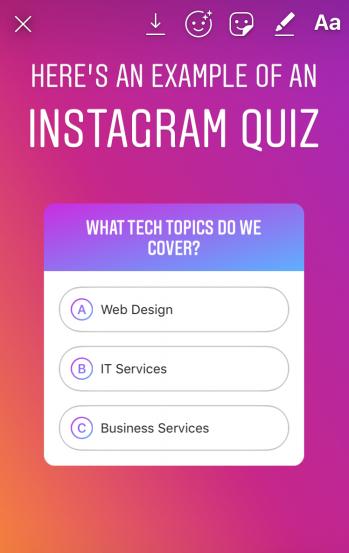
Quizzes are interactive, and the results are easy to view in an Instagram account.
Pinterest Is Emerging as an Effective Platform for B2C Small Businesses
Small businesses looking to build brand awareness are also using platforms such as Pinterest to build trust and authority with users.
“Pinterest is an important platform for B2C brands because that’s where people are going to plan big moments in their life, and they’re looking for inspiration," Knights said. "If you can get your products in front of them, at that early stage, … then you’re going to set yourself up for success in the future.”
In 2018, Pinterest announced that it had reached 250 million monthly active users. The same survey showed that 78% of people on Pinterest found branded content on the platform useful.
Lily Stern, social media analyst at real estate blog The Close, uses Pinterest to promote the brand.
“Pinterest is a diamond in the rough not many small businesses think to use, but it’s the perfect platform to connect with our target audiences,” Stern said.
The Close’s Pinterest account has more than 3,500 followers and several custom boards organized by advice, decorating tips, and lead generation.
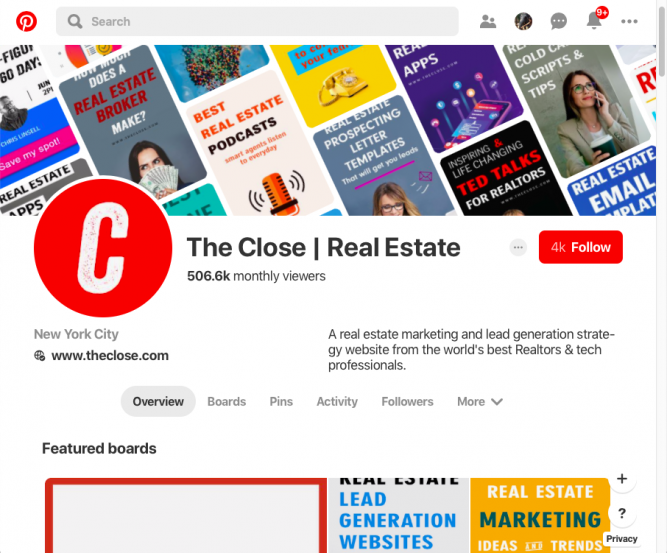
Pinterest is visual and user-friendly, meaning that The Close’s audience can navigate to the content they want quickly and easily.
Stern says that The Close's audience of real estate professionals goes to Pinterest for inspiration.
“We provide real estate professionals with strategy, industry insights, and tools they can use to make more sales,” Stern said. “A large portion of those professionals are on Pinterest.”
Pinterest acts as a content hub for The Close, and its account has more than 500,000 monthly views.
The Close’s 42 boards include original graphics and interior design shots to inspire its audience. These images are searchable with Pinterest’s visual search function, Lens, shown below.

Lens makes it easier for users to access content they want by searching with their mobile device’s camera.
Pinterest Lens can lead real estate professionals to any one of The Close’s home décor inspiration boards, shown below.
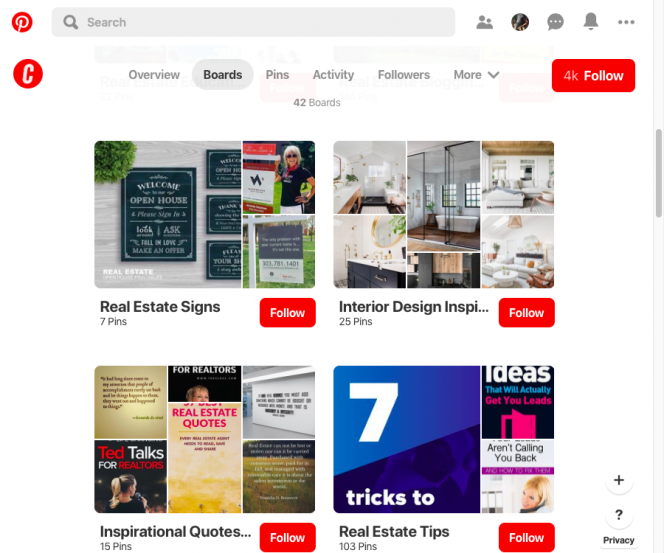
According to Stern, the high-quality content The Close includes on its Pinterest page answers audience queries on Pinterest Lens, which has boosted its monthly viewers and led to more conversions.
Pinterest is a dynamic social media platform that’s ideal for B2C small businesses looking to engage audiences with visual content.
Social Media Platforms Small Businesses Prioritize Depend on the Business Owners’ Age
The platforms small businesses plan to increase investment in vary based on the age of the business owner and the age of the intended audience.
Almost half of millennial small business owners ages 18 to 34 (43%) plan to increase investment in Instagram in 2019, compared to just 25% of Generation X owners ages 35 to 54.

Zatorski, however, believes that small businesses chose which platforms to invest in based on the age of the potential customers, not the owner.
“It has less to do with the age of the business owner and more with the age of the target audience,” Zatorski said.
Small businesses use different platform based on the age of their target market, though younger business owners may be more tech-savvy and therefore more inclined to use platforms outside of Facebook.
Younger generations use social media differently – according to a Visual Objects report from January 2019, millennial and Generation Z website users prefer visual platforms such as Instagram and YouTube over Facebook.
Though small businesses with younger owners gravitate toward certain platforms, this is likely due to both the age of the target audience and the company itself.
Social Media Influencers Can Help Small Businesses Build Trust With Their Audiences
Influencers have become almost synonymous with Instagram. According to a 2019 study, there are more than 500,000 influencers on Instagram.
Social media influencers are becoming a popular resource for small businesses looking to manage their social media channels. One-quarter of small businesses (25%) use influencers to help maintain their social media presence.

Influencers help small businesses create content to promote their brand, and their network of followers can build trust in a company’s product or service.
Alex DiBacco is a social media influencer with more than 40,000 followers. She works with small and large businesses to create sponsored content integrated into her lifestyle brand, Chasing Daisies.
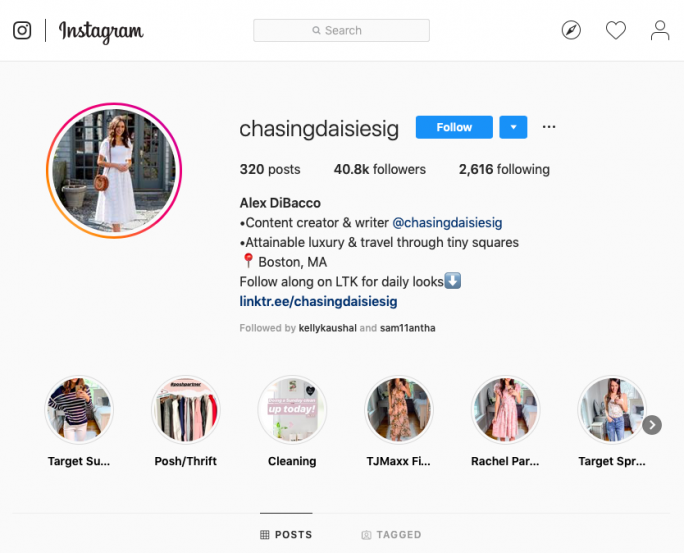
DiBacco’s Chasing Daisies Instagram account and blog blends organic posts about travel, food, and fashion with branded content from other businesses.
She says that small businesses can benefit from partnerships with influencers.
“The biggest advantage to using influencer marketing tactics is brand awareness,” DiBacco said.
Brand awareness, according to DiBacco, sometimes requires additional effort for small businesses up front.
“It usually takes a purchaser three different times of seeing an item (in three different ways) to make a purchase,” DiBacco said. “While some influencers do generate a huge amount of sales after showcasing an item, it's more likely that a business will need to work with a few different influencers to get the ball rolling.”
According to DiBacco, customers usually need to see a product multiple times online before making a purchasing decision. For this reason, small businesses should start by cultivating partnerships multiple influencers.
“Once a product is showing up on multiple different Instagram grids … [it] becomes more popular,” DiBacco said.
DiBacco recommends that small businesses start by working with several influencers at once to market products across several accounts for increased exposure.
Social media influencers are an accessible resource for small businesses looking to reach a wider audience and maximize content creation efforts.
Influencers Can Replace Online Marketing Agencies for Small Businesses with Limited Budgets
Small businesses recognize that influencers are a growing force in the social media space and often less expensive than hiring an agency.
DiBacco contends that working with influencers to manage social media is an affordable option for small businesses that are hesitant to commit to a digital marketing agency**.
“Influencers are generally cheaper,” DiBacco said. “Smaller influencers may work for product trade, while larger influencers will charge a fee that is still usually less than an agency.”
According to Digiday’s 2017 State of Influencer Marketing Report, the more followers an influencer has, the more expensive he or she is likely to be. Influencers with 500,000 to 1 million followers can charge between $5,000 and $10,000 per post.
Small businesses with a smaller budget can hire influencers with smaller numbers of followers in a targeted market.
Small businesses looking to hire influencers should conduct thorough research on the influencers, their audience, and their price range.
Influencers’ audience and reach are two benefits that may be worth the cost of investment, though, as long as small businesses research and identify the right individuals to partner with.
Larger Companies With More Resources Invest in More Social Media Platforms
Small businesses with 50 or more employees are better equipped to invest in a diverse set of social media platforms to meet their business goals. Smaller teams have limited time and resources and, therefore, must select social media platforms strategically.
Small businesses with 10 or fewer employees prioritize Facebook – 91% of them invest in the platform, compared to 65% of businesses with 10 or fewer employees.
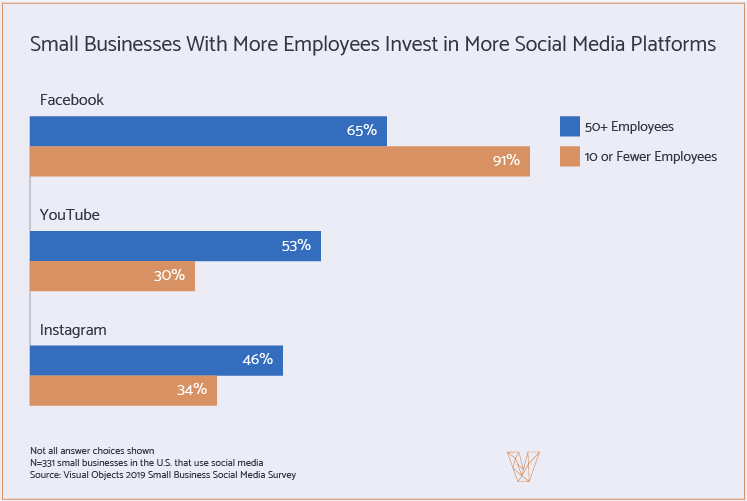
Small businesses with 50 or more employees are also more likely to invest in YouTube – 69% use the platform, which is almost twice the 34% of smaller businesses with 10 or fewer employees that use YouTube.
Small businesses with larger teams are better equipped to manage multiple social media accounts simultaneously.
For smaller teams, Knights recommends prioritizing activity on a few platforms at a time.
“Small businesses should start with their two most relevant platforms,” Knights said. “Don’t try and spread yourself across all the platforms just to be present. You want to actually create good and meaningful content on the platforms that you’re on.”
Small businesses that focus social media efforts on two platforms can maximize their reach and ensure they provide high-quality content on those channels.
Jacob Landis-Eigsti owns a video production company, Jacob LE Video Production, in Denver. He manages his social media accounts on his own, with some assistance from hired contractors.
“I manage Facebook, Twitter, YouTube, Instagram, LinkedIn, and Pinterest for my business,” Landis-Eigsti said. “I’m able to keep up with all of them by using a content calendar. I strategically create content that can be used on multiple platforms.”
Landis-Eigsti tailors his content to his audience of current and potential clients, repurposing content to use across platforms.
“I’ll create a 7-minute YouTube video, then take 1-minute clips to share on Facebook and Instagram, and turn the video transcript into a blog that I can share on Pinterest and LinkedIn,” Landis-Eigsti said.
By repurposing a longer piece of content, Landis-Eigsti creates content for multiple platforms on his own.
Small teams can still maintain accounts on multiple social media platforms but must plan their content strategically.
Most Small Businesses Maintain Their Social Media Accounts, but Some Will Decrease Investment in 2019
Social media remains an important outlet for small businesses looking to promote their brand affordably. Still, social media investment is all about the perceived return or results: About one-third of small businesses say they plan to invest less in at least one social media platform in 2019.
Small businesses that choose to decrease investment in social media do so because they aren’t seeing return on that investment.

Some experts believe that the small businesses that plan to scale back their social media use will do so because they are not making the best use of their time on different platforms.
“If companies are trying to decrease their spending on social media, they probably don’t understand how to use those tools to reach their audience,” said Tim Hemingway, vice president of marketing at Disruptive Advertising.
Hemingway argues that small businesses should use social media to engage with their target audience rather than advertise a product to them.
“The first thing you have to do is take a step back and really figure out who is willing to engage with [you] on social media,” Hemingway said. “Once you have a better understanding of who your audience is, that’s going to help cater the message.”
Small businesses can work to engage their target audience on different social media platforms once they figure out who the audience is and what content they want.
Jacob Landis-Eigsti plans to decrease investment in Twitter, Instagram, and Facebook by about 50% because these platforms do not provide his business the desired return on investment.
“On Twitter, Instagram, and Facebook, the lifespan of a post is too short,” Landis-Eigsti said. “I don't feel the social networks drive enough traffic to my website. It's time-consuming constantly coming up with content, and I believe blogging and email marketing yield a better return on investment.”
Social media offers the flexibility for small businesses to choose where to invest time and resources. If efforts are not providing ROI, it’s easy for businesses to adjust their strategy accordingly.
Small Businesses Choose Social Media Platforms According to Their Unique Business Needs
Facebook still dominates social media for small businesses, but the use of other platforms such as Instagram and YouTube depend on a company’s size and industry and the business owner’s age.
Most small businesses plan to increase their use of social media in 2019. The age of the business owner factors into what platforms a business will use, with younger owners leaning toward visual platforms such as Instagram.
Small businesses struggling to create content for social media can partner with influencers, particularly on Instagram. Influencers are a cost-effective way for small businesses to build trust in their brand.
Companies with larger staff can invest in more social media platforms. Smaller companies, however, should focus on posting consistently on two platforms instead of occasionally on several platforms.
Most small businesses will not decrease their investment in social media in 2019. Social media makes it easy for small businesses to adjust their investment in the platform according to their needs.
Social media is here to stay, especially for small businesses looking to expand the reach of their brand in 2019.
About the Survey
Visual Objects surveyed 529 owners and managers of U.S.-based small businesses with 1 to 500 employees.
More than half of small businesses surveyed (54%) had between 1 and 10 employees, and 46% had between 11 and 500 employees.
Most respondents were male (52%), and 48% of respondents were female.
Millennials (ages 18-34) made up 29% of respondents; 45% were Generation Xers (ages 35-54), and 27% of respondents were baby boomers (ages 55+).